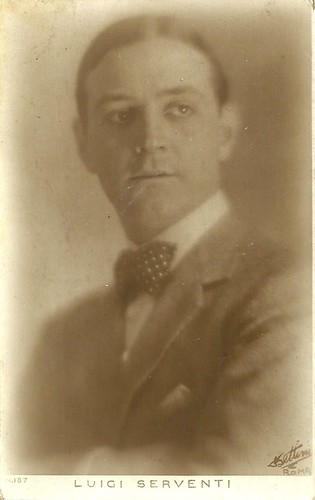
Italian postcard by Ed. Vettori, Bologna.
Specialized in romantic roles
Luigi Serventi aka Gigi Serventi was born in Rome in 1885. He came from a Roman bourgeois family.
He started his stage acting career in 1911, entering the theatre company of Vittoria Lepanto. Afterwards he moved over to the companies of Ermete Novelli and Ettore Berti.
In 1914 he abandoned the stage to fully dedicate himself to film acting, first as an extra at the Latium Film company. Later, he worked for other production companies, such as Pasquali, Cines, Milano, Itala, etc.
He was the male lead in successful films such as Il vetturale del Moncenisio/The Courier of Moncenisio (Leopoldo Carlucci, 1916) with Lina Millefleurs, Il Re, le Torri e gli Alfieri/The king, the Towers and the Ensigns (Ivo Illuminati, 1917), a rare, lost futurist film with Giorgina Dentice di Frasso, Il padrone delle ferriere/The owner of the ironworks (Eugenio Perego, 1919) with Amleto Novelli and Pina Menichelli, and Il romanzo di un giovane povero/The romance of a poor young man (1920) with again Menichelli.
Serventi confirmed himself as one the male stars of Italian cinema in the silent era. He specialized in romantic roles, and in a period of five years he acted together with many of the female stars of the Italian cinema.
With Mercedes Brignone, he co-starred in Vizio atavico/Ancestral vice (Baldassarre Negroni, 1914), La dote del burattinaio/The Puppet's Dowry (Baldassarre Negroni, 1914), Lo spettro bianco a Saint Moritz/The white specter in Saint Moritz (Alfredo Robert, 1914), and Mezzanotte/Midnight (Augusto Genina, 1915).
He also co-starred with Hesperia in Per la felicità degli altri/The Penalty of Beauty(Baldassarre Negroni, 1914) and Dopo il veglione/After the New Year's Eve (Augusto Genina, 1914), with Bianca Virginia Camagni in Non è tutto oro/It is not all gold (1914), with Gemma Stagno Belllincioni in Cavalleria rusticana (Ugo Falena, 1916) and with Leda Gys in La Bohème (Amleto Palermi, 1918).
Most famously Serventi co-starred with the diva Pina Menichelli. They acted together in two films directed by Augusto Genina, La parola che uccide/The word that kills (Augusto Genina, 1914) and Il mistero del castello di Monroe/The Munroe Manor Mystery (Augusto Genina, 1914), and later in five by Eugenio Perego and one by Amleto Palermi, the Octave Feuillet adaptation Il romanzo di un giovane povero/The romance of a poor young man (1920).
In 1914-1915 Augusto Genina directed Serventi in eight films and during the 1920s in two more. Other directors with whom Serventi frequently worked were Baldassarre Negroni (1914-1915), Ugo Falena (1916-1917) and Eugenio Perego (191-1920).
Occasionally, Serventi tried his luck with film direction. He co-directed with Lucio D’Ambra Le mogli e le arance/The wives and the oranges (1917), and solo he did Suprema bellezza/Supreme beauty (1921). In both films he also played the male lead.

Italian postcard by Ed. Vettori Bolognam no. . Publicity still of Pina Menichelli and Luigi Serventi in Il romanzo di un giovane povero/The romance of a poor young man (1920). The proud Margherita (Menichelli), daughter of the rich Laroque, falls in love with her father's administrator, Massimo Odiot (Serventi), but she fears he is only after her money. The real vulture, however, is a corrupt count, to whom Margharita is betrothed, unknowing of the man's plans. When Massimo and Margherita are accidentally locked into an old tower, and she treats him cruelly, Massimo sacrifices himself and jumps from the tower, to get help. When afterwards he gets hold of a fortune, nothing can prevent anymore the marriage between the two.

Italian postcard by Ed. Vettori Bologna, no. 1052. Publicity still of Pina Menichelli and Luigi Serventi in Il romanzo di un giovane povero/The romance of a poor young man (1920).

Italian postcard by Ed. Vettori Bologna, no. 1038. Publicity still of Pina Menichelli and Luigi Serventi in Il romanzo di un giovane povero/The romance of a poor young man (1920).
German aristocrats
Because of the crisis in the Italian film industry, Luigi Serventi emigrated to Germany in 1922.
In Berlin he met the same public acclaim, when he appeared in several films, opposite female stars emigrated to Berlin like him, such as Lucy Doraine, Maria Jacobini and Diana Karenne.
His first German film was Sterbende Volker/Dying people (Robert Reinert, 1922), which had an all-star cast that included Fritz Kortner, Helena Makowska, Aud Egede Nissen, Otto Gebühr, Gustavo Serena and Paul Wegener.
In Germany, he often played aristocrats, as in Bohème - Künstlerliebe/Bohème - artists love (Gennaro Righelli, 1923), Der Geldteufel/The Money Devil (Heinz Goldberg, 1923), Finale der Liebe/Finale of Love (Felix Basch, 1925), and Die Ausgestoßenen/Caught in Berlin's Underworld (Martin Berger, 1927).
Serventi also acted in Czechoslovakia in the films Muz bez srdce/The Man Without a Heart (1923) and Vyznavaci slunce/The Sun Disciples (Václav Binovec, 1926), and Erotikon/Seduction (Gustav Machatý, 1929) starring Ita Rina. In Austria he starred in Lebende Ware/Living goods (Robert Wohlmuth, 1929).
Yet, Serventi was also called back to Italy to act in films such as Voglio tradire mio marito/I Want to Betray My Husband (Mario Camerini, 1925) with Linda Pini and Alberto Collo, Il gigante delle Dolomiti/The Giant of the Dolomites (Guido Brignone, 1927) with Bartolomeo Pagano in his final Maciste film, and Il cantastorie di Venezia/The Storyteller of Venice (Atto Retti-Marsani, 1929).
When sound cinema set in, Serventi’s career started to fade way. His last true film part was in Berge in Flammen/Mountains on Fire (Luis Trenker, Karl Hartl, 1931) with Luis Trenker and Lissi Arna. One of the series of popular Mountain films of the era, it was shot on location in the Dolomites.
In the same year Serventi settled in Kitzbühel, Austria, and remained there for many years. Only at a very high age he returned to Italy.
Luigi Serventi died in Rome, in 1976.

Italian postcard by Ed. Soc. Anon. It. 'Bettini', Roma , no. 187. Photo: Bettini, Roma.

Italian postcard by Ed. Vettori, Bologna, no. 220. Photo: Civirani, Roma.
Sources: Wikipedia (English and Italian) and IMDb.
No comments:
Post a Comment